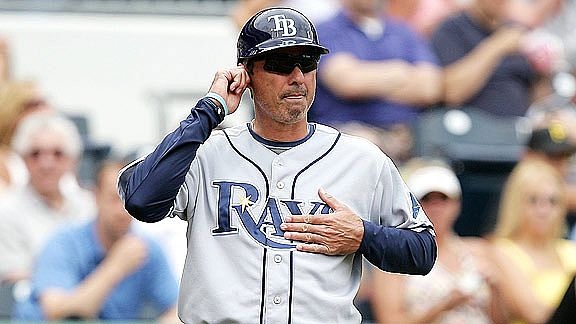The wipe off sign
August 26, 2013 by Coach McCreary
Filed under Coaching
My three older sisters were not into sports and didn’t know much about baseball. However, for some reason, all were fascinated by coaches signs. When they watched a game, they loved watching coaches flash signs to the
players and always wanted to know what my signs were for my players. When I told them a few, they were usually a bit disappointed. “That’s it?” is what they would typically say. Basically, they thought signs were supposed to be very complicated. They are not. At least they shouldn’t be.
This past winter I had a chance to meet and talk with Nick Leyva who is the current third base coach for the Pittsburgh Pirates. I asked him how complicated his signs were. He said if a player can count to four, he’ll never miss a sign. He elaborated on what that meant but the basic message was, they were not difficult at all.
By far, the most effective way to simplify your signs as a coach is to incorporate a “wipe-off sign” into your repertoire. I don’t care how simple your signs are, if you use a wipe-off sign, your signs will never be stolen. Here is what I mean:
Let’s say your signs involve only the very first sign you give. No indicator sign at all. Just the first sign.
(Note: For those who don’t know, an indicator sign is a “trigger” sign that tells the batter that the actual sign is coming next. For example, if the sign for bunt is the ELBOW and the indicator is the HAT then the coach will give the indicator sign and then the bunt sign after that – HAT then ELBOW. If the coach just gives the bunt sign – ELBOW – without the indicator sign first, no bunt is on.)
For our example, just the first sign is used. The elbow is the bunt sign. If the coach touches the elbow with his first sign, the batter bunts. No indicator. You can’t get more simple than that unless you just verbally tell the batter to bunt – which I have done on a few occasions.
However, if the signs are that basic, they can more easily be deciphered by the other team. That’s why you use a wipe-off sign. Let’s say the wipe-off sign is the belt. The coach gives any signs he wants at any time in the sequence but if he ever touches his belt, nothing is on. It wipes everything away.
When I gave signs, I would typically give steal signs, bunt signs, suicide squeeze signs, etc. all game long and just used the wipe-off sign to take it away. The other team got used to me giving all those signs so when I actually put a play on, I just didn’t use the wipe-off sign.
Some coaches will use a wipe-off sign as their first sign as a way of telling their players, “No matter what sign I give afterwards, it means nothing.” Some will give the wipe-off sign only as their last sign in case they mistakenly give a sign early on in the sequence. The wipe-off sign allows them to take it off after the fact. Some coaches use it at any time during their sequence.
Often, making your signs complicated does more to fool your own players than the other teams’. Make it much easier by adding a simple wipe-off sign.
Tomorrow’s post: The stat I’d like to see






Leave a Reply